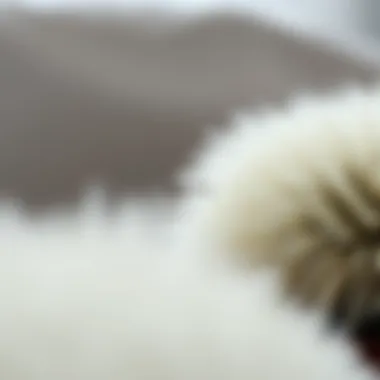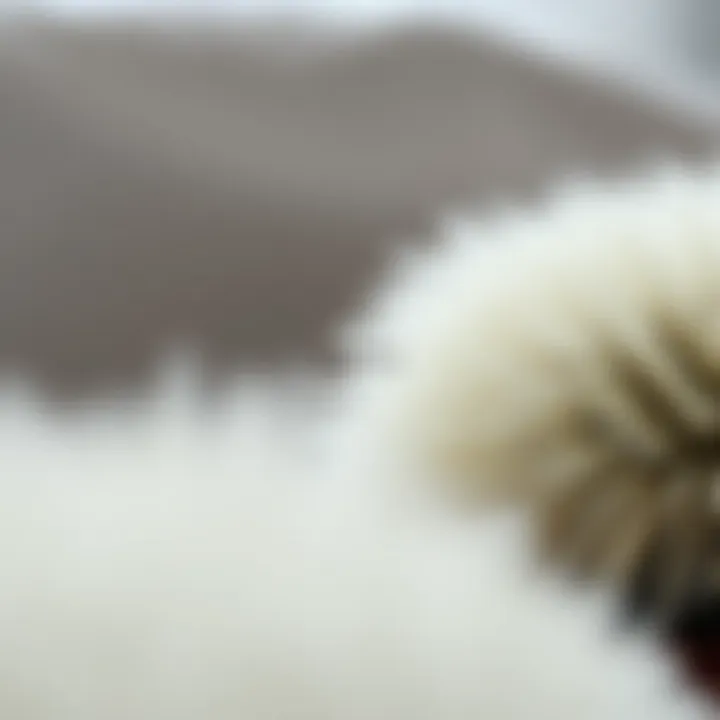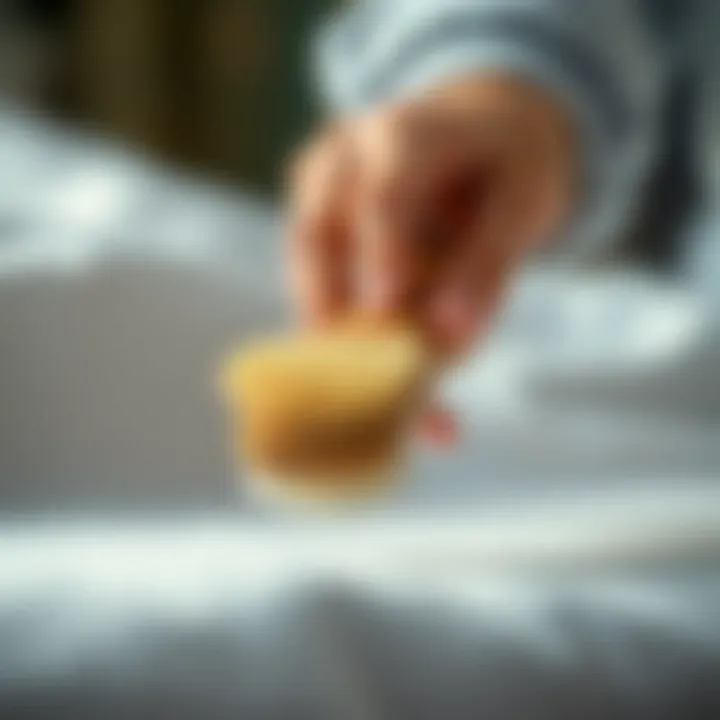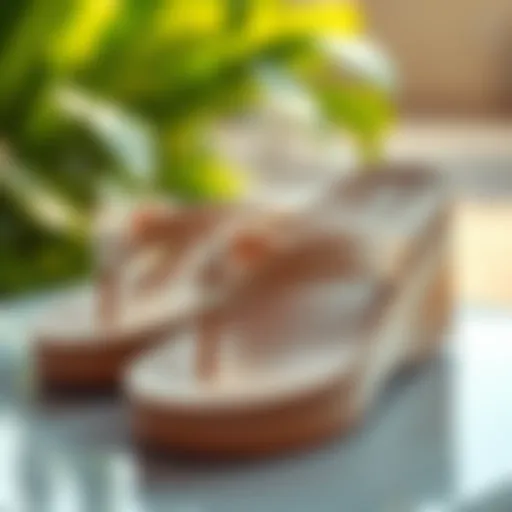Long Handle Stiff Bristle Brushes for Fabric Care


Intro
In the world of fabric maintenance, long handle stiff bristle brushes stand out as practical tools, often overlooked but immensely useful. Their design allows for reaching tricky spots, making them a staple for anyone serious about caring for their textiles. From delicate fabrics like silk to robust materials such as canvas, these brushes prove versatile in tackling various cleaning challenges. This article will guide you through the nuances of employing these brushes effectively, ensuring your clothing looks fresh and lasts longer.
Fabric Knowledge
Understanding the different types of fabrics is crucial when using a brush, as each material has its sensitivities and needs.
Types of Fabrics
- Cotton: One of the most common fabrics, cotton is lauded for its breathability and comfort. It's sturdy, making it suitable for scrubbing with stiff bristle brushes.
- Wool: Wool is a delicate material that requires a gentler hand. Although a stiff brush can help remove pilling, caution is key to avoid damaging the fibers.
- Silk: This luxurious fabric can easily be harmed. A long handle stiff bristle brush may not be the best option; instead, using a softer brush or cloth is advisable.
- Denim: Sturdy yet stylish, denim can withstand a good brushing. It helps to maintain the fabric’s texture and remove dirt effectively.
- Synthetic Fabrics: Materials like polyester or nylon are durable and can often handle a stiff brush without issue. They can benefit greatly from thorough cleaning.
How to Care for Different Fabrics
Using long handle stiff bristle brushes can vary widely based on the fabric.
- For Cotton: Brush in long strokes along the nap of the fabric to lift dust and dirt.
- For Wool: Use the brush lightly, just enough to remove surface debris. Avoid pressing too hard to protect the natural fibers.
- For Silk: It’s better to shake out the silk fabric, and if a brush is necessary, a very soft one.
- For Denim: Take advantage of the brush's rigidity and focus on seams where dirt accumulates.
- For Synthetics: Brushes are excellent for synthetic fabrics since they aren't as fragile as natural fibers.
An important thing to remember is to always test a brushing technique on a small area first, especially on delicate fabrics, to avoid any unintended damage. The effectiveness of a long handle stiff bristle brush can be truly remarkable, provided you know which way to wield it.
"The right tool inhand can save you time and efforts in fabric care, showing that brushes can enrich our daily routines."
Style Tips
To maximize the care of your fabrics, integrating smart style tips is equally beneficial. Pairing your freshly cleaned garments with the right accessories can elevate your whole look.
Outfit Pairing Strategies
- Mix Textures: Combine fabrics like denim and cotton for a balanced look. The contrast can draw attention to the brush's capability as a fabric care solution.
- Accessorize Wisely: A colorful scarf can bring attention to a plain outfit, ensuring your cleaned fabric stands out.
Seasonal Fashion Trends
Knowing the latest trends can help frame how you approach fabric care. Keep an eye on shifts in color palettes and fabric popularity each season to ensure your wardrobe reflects current styles.
For example, as we tip into autumn, wool and flannel resurface, necessitating tailored care routines to maintain their quality. Conversely, in the spring, more breathable materials like cotton will likely have a front-row seat in your closet.
Intro to Long Handle Stiff Bristle Brushes
The topic of long handle stiff bristle brushes holds substantial significance in the world of fabric care. These brushes are not just basic tools; they serve several crucial functions, enhancing the maintenance of textiles and garments significantly. With the rise of sustainable fashion and the need to protect investments in clothing, understanding this tool becomes even more essential. In an industry overly saturated with products, knowing how to effectively care for fabrics with the help of these brushes sets a distinguished approach to garment longevity.
One of the prominent benefits of long handle stiff bristle brushes is their versatility across various fabric types. For instance, whether dealing with wool, cotton, or synthetics, these brushes provide a thorough cleaning method that goes deeper than mere surface care. Their design allows for better reach, giving users the ability to clean hard-to-reach areas without straining, which can be especially crucial for larger garments or upholstery.
Moreover, the importance of these brushes in preserving fabric integrity cannot be stressed enough. They aid in removing dust, lint, and even stubborn dirt without damaging the threads or fibers of the fabric. This function is particularly vital for fashion enthusiasts and stylists who often work with delicate fabrics.
Their strategic functionality underlines a significant consideration: being in tune with the needs of fabrics and materials. Selecting the appropriate brush based on bristle firmness, handle length, and quality of materials can make or break a fabric care routine.
Thus, the upcoming sections will explore further details of long handle stiff bristle brushes, their anatomy, practical applications, and proper maintenance techniques. Understanding these aspects will help both casual consumers and industry professionals alike integrate this indispensable tool into their everyday fabric care practices.


Anatomy of the Brush
Understanding the anatomy of long handle stiff bristle brushes is crucial for appreciating their role in fabric care. Each component plays a vital role in how the brush functions, contributing to its effectiveness in various textiles. A good grasp of the brush's design can enhance your ability to select the right tool for specific cleaning tasks, ensuring longevity and optimal performance.
Components of a Stiff Bristle Brush
Handle
The handle of a stiff bristle brush is more than just a means to hold the bristles; it significantly influences the ease of use and control during application. A longer handle provides the advantage of reaching awkward spots without strain on the body. Many handles are crafted from materials like wood or reinforced plastic, which offer durability alongside comfort.
One might say a sturdy handle is the backbone of the brush. It must be both robust and lightweight, allowing for vigorous use without causing fatigue to the user. A well-designed handle often features ergonomic grips that enhance comfort, making brushing sessions less of a chore.
However, not all handles are created equal. A potential downside of a wooden handle is its susceptibility to moisture damage, while a plastic one might bend under excessive force. To some extent, the choice of material can impact your brushing technique and the results you achieve on delicate fabrics.
Bristles
The bristles are arguably the heart of the brush. Made from synthetic materials or natural fibers, they are designed to offer an optimum balance between stiffness and flexibility. The important characteristic of bristles lies in their ability to dislodge dirt and dust without damaging the underlying fabric. Stiff bristles can clean harder surfaces, while softer options can gently care for delicate textiles.
A unique aspect of stiff bristles is their resilience; they maintain their shape and effectiveness throughout countless uses. However, the stiffer the bristle, the more careful one must be not to apply undue pressure on sensitive fabrics, which could lead to worn spots or snags. Choosing a brush with the right bristle stiffness is thus fundamental to preserving your garments in pristine condition.
Filling Material
Filling material in a stiff bristle brush refers to what’s used to keep the bristles secure and in place, giving structure to the brush itself. Typically a blend of compacted fibers, this material contributes to the brush's overall durability and performance in cleaning tasks. The right filling material allows the bristles to move freely while maintaining a solid base.
The characteristic that sets the right filling apart is its resilience against wear over time. If a brush has superior filling, you won’t just extend its lifespan but also enhance its effectiveness during use. On the flip side, inferior filling can lead to bristles losing their placement or integrity, negatively impacting cleaning efficiency.
In summary, the components of a long handle stiff bristle brush work together in a symbiotic fashion, each playing its part to deliver results in fabric care. Understanding these elements can empower users, allowing them to select tools that best suit their specific needs in maintaining fabric quality and longevity.
Practical Applications in Fabric Care
The importance of practical applications for long handle stiff bristle brushes in fabric care cannot be overstated. These brushes serve a multitude of purposes, making them indispensable tools for anyone invested in maintaining the quality of textiles, from casual clothing to delicate fabrics. Understanding how to effectively use them can lead to significant improvements in textile maintenance, prolonging the lifespan of garments and keeping them in pristine condition. Furthermore, these brushes are not just for cleaning; they can also revive fabrics that have lost their original charm, serving as both a cleaning and restoration tool.
Effective Dust and Lint Removal
When it comes to effective dust and lint removal, the stiff bristle brush is a heavyweight champion. The design and bristle configuration allow it to tackle stubborn debris that clings to fabric surfaces, making it a fantastic choice for everyday maintenance. For instance, when you swipe this brush across a wool sweater, it pulls off lint and dust that even a lint roller couldn't manage.
To keep in mind:
- Use short, firm strokes, going with the fabric's grain for optimal results.
- You can roll the brush in one direction and lift to avoid pushing lint back into the fabric.
This method is particularly useful for garments that require meticulous care, like suits or delicate blouses. Even a brief brushing session can prevent wear and maintain freshness, making the clothing more visually appealing.
Restoring Fabrics After Washing
After a wash, fabrics can look a little worse for wear; long handle stiff bristle brushes come to the rescue here too. They excel at fluffing up fabrics that have flattened during the washing process. For example, a cotton shirt may feel limp and lifeless, but a few strokes of the brush can restore its original texture and appearance.
What to do:


- Let the fabric dry completely, in case it retains moisture.
- Use gentle pressure to avoid damaging the fibers.
By revitalizing the texture, you can give your clothes a second wind after a wash. It's an essential step to keeping fabrics in optimal shape!
Techniques for Cleaning Delicate Textiles
Cleaning delicate textiles requires a gentle touch, and the long handle stiff bristle brush can be used in such a way that respects fragile materials. For silk scarves, for example, the technique becomes crucial. You don’t want to tug too hard or scrub and ruin the fabric.
Here's how to approach delicate items:
- Test First: Always tackle a small, inconspicuous area to gauge the brush’s impact on the fabric.
- Light Touch: Use the brush lightly, almost as if you’re tickling the surface.
- Brush Stroke Direction: Follow the weave pattern to avoid pulling and damaging the threads.
These methods can make a significant difference in cleaning results without compromising delicate fabrics. With care, you can keep even the most fragile of textiles looking immaculate.
"Proper maintenance and use of long handle stiff bristle brushes can extend the life of your fabrics and enhance their appearance, elevating your overall wardrobe experience."
In summary, these applications highlight how versatile and essential long handle stiff bristle brushes can be in fabric care. Whether for general maintenance, post-wash restoration, or cleaning delicate textiles, they prove themselves as valuable allies for anyone aiming to maintain high-quality fabric.
Selecting the Right Brush
Choosing the right long handle stiff bristle brush is a pivotal decision in maintaining and caring for fabrics effectively. A brush that fits the specific needs of your materials can mean the difference between preserving their quality or causing damage. Various factors come into play when selecting the perfect brush, including bristle firmness, handle length, and the quality of materials used in its construction.
Understanding these elements will not only guide your purchase but also enhance your fabric care routine. A well-informed selection process ensures you are equipped with an effective tool that meets the demands of your fabrics, leading to better longevity and upkeep.
Factors to Consider
Bristle Firmness
Bristle firmness is perhaps the most essential aspect to consider when choosing a brush. The firmness of the bristles can significantly affect the brush's performance across different fabric types. Soft bristles are gentle on delicate materials, making them a popular choice for silks or fine linens, while stiff bristles can navigate tougher fabrics like canvas or upholstery with more efficacy.
Key Characteristics: Stiff bristles allow for a thorough, deep clean, effectively dislodging dirt and debris that may cling to sturdier fabrics. However, the potential downside is that using overly stiff bristles on sensitive textiles can lead to fraying or damage. Thus, selecting a balance according to the fabric's needs is crucial.
Handle Length
The length of the handle has implications beyond the aesthetic; it affects the brush's usability and your comfort during cleaning. A long handle can provide better leverage and reach, allowing you to clean hard-to-access areas without straining your back. This feature can be particularly advantageous when dealing with larger items or garments hanging on high lines.
Key Characteristics: A longer handle can enhance not just reach, but also control. For instance, when brushing a coat draped over a hanger, a lengthy handle allows for a gentler touch without awkwardly twisting your wrist. The challenge, however, lies in maneuverability—too long, and it can become cumbersome.
Quality of Materials
The quality of materials used in the construction of the brush is vital for its durability and effectiveness. Brushes made from high-quality bristles and sturdy handles tend to withstand wear and tear better than their cheaper counterparts. Investing in a well-made brush can pay off significantly, producing better results and lasting longer.
Key Characteristics: High-quality materials often mean a more effective performance. For example, natural bristles can provide a gentler cleaning action while still being robust, suitable for a range of fabrics. However, it’s also important to consider the environmental impact of material choices, as synthetic options might be less environmentally friendly but can offer longer-lasting durability.
Brands and Recommendations
While there are numerous brands out there, some tend to stand head and shoulders above the rest when it comes to quality long handle stiff bristle brushes. Brands like Oxo, known for ergonomic designs, and The Brush Company, which specializes in high-quality materials, are often recommended. Tailoring your choice to the specific fabric care needs will ensure that you not only maintain the fabric’s integrity but also enhance your overall cleaning routine.


Care and Maintenance of the Brush
Maintaining a long handle stiff bristle brush isn't just a chore; it's a crucial step in ensuring the tool remains effective and extends its lifespan. Proper care can transform a mundane cleaning task into a more efficient process. Taking time for maintenance means investing in the longevity and effectiveness of your brush, allowing it to perform optimally every time you reach for it. Given the various fabrics and dirt types you might encounter, a well-maintained brush can adapt to the demands of your cleaning tasks with grace.
Cleaning Techniques for Longevity
Cleaning your brush might seem straightforward, but a few simple techniques can go a long way. Here are effective methods to ensure your brush has a long life:
- Regular Rinsing: After each use, it’s advisable to rinse the bristles under warm water. This eliminates dust, lint, and any debris that might have accumulated. Avoid hot water, as it can warp the handle over time.
- Gentle Bristle Care: It helps to periodically wash the bristles with a mild soap or detergent. Gently work the soap into the bristles before rinsing thoroughly. This not only cleans but also prevents stiffness from build-up.
- Remove Embedded Fibers: For those stubborn fibers stuck in the bristles, using a pair of tweezers can be effective. Picking these out will help preserve the bristle integrity and ensure maximum cleaning power.
- Drying Process: After washing, allow the brush to dry upright in a well-ventilated area. Hang it by the handle if possible, as laying it flat might trap moisture and lead to mold or deterioration of materials.
Implementing these techniques will assist in maintaining the bristle condition and ensuring it remains an effective tool in your fabric care arsenal.
Storage Best Practices
Where and how you store your brush can significantly affect its functionality. Here are some practices to keep in mind:
- Cool, Dry Place: Always store the brush in a cool, dry area away from direct sunlight. This prevents warping of the handle or degradation of the bristles.
- Avoiding Pressure: If you keep the brush in a drawer or a bag, ensure it is not being pressed against other items. This can bend the bristles and affect its cleaning performance.
- Using a Brush Holder: If space allows, consider using a dedicated brush holder. A holder can keep the bristles clean, prevent compression, and protect them from dust accumulation.
- Periodic Inspection: Every once in a while, it's wise to check your brush for signs of wear. This includes inspecting the handle for cracks or the bristles for significant fraying. Addressing these issues early can save you from replacing the brush too soon.
By applying these storage strategies, you ensure that your long handle stiff bristle brush remains at peak performance, ready to tackle various fabric care tasks when needed.
Environmental Considerations
When delving into the realm of long handle stiff bristle brushes in fabric care, it’s imperative to address environmental considerations. The impact of our choices, however seemingly small, can have substantial effects on both the planet and our fabric maintenance routines. The material composition of the brush and how it’s used contribute not only to the longevity of textiles but also to the sustainability of our earth’s resources.
Sustainability of Material Choices
The materials employed in the construction of stiff bristle brushes play a crucial role in their environmental footprint. Traditional plastic handles and synthetic bristles can indeed offer durability and resilience, but this comes at a cost—both environmentally and, sometimes, to the bristle’s performance. Searching for brushes made from sustainable options, such as bamboo handles combined with natural bristles, can significantly lessen the burden of non-biodegradable waste on landfills. Here’s why opting for sustainable materials is a fruitful choice:
- Biodegradability: Natural materials tend to break down better over time than synthetics, thereby reducing landfill impact.
- Renewable Resources: Materials such as bamboo are fast-growing, making them an excellent choice for sustainable manufacturing.
- Less Toxicity: Using natural materials often means fewer chemicals in the manufacturing process, benefitting both the maker and the consumer.
Choosing a brush built on sustainable principles aligns fabric care practices with a healthier planet. When you invest in a product that embodies eco-friendliness, you not only enhance your care routine but also take a step toward responsible consumption.
Reducing Waste Through Proper Use
Understanding how to properly utilize long handle stiff bristle brushes can minimize waste far more than one might think. Not every brush out there will last a lifetime; however, with the right techniques, you can extend its life significantly. Here are some vital practices to consider:
- Avoid Excessive Force: Using too much pressure when brushing can cause bristles to fray and break. Let the tool do the work.
- Regular Cleaning: Keeping the brush clean prevents the buildup of debris, which can diminish its effectiveness and durability.
- Store Properly: Positioning your brush in a dry location—ideally standing upright to preserve bristle shape—can prevent damage and prolong usage.
By keeping these practices in mind, you can ensure that your brushes last longer, reducing the frequency of replacements and ultimately lessening your waste output. Proper maintenance and mindful use go a long way in cutting down on new purchases, which is beneficial for the environment.
In summary, when fabric care meets conscious consumption, the implications resonate far beyond just individual tastes. Embracing sustainable choices in materials and using brushes judiciously can pave the way for a more eco-friendly approach to caring for our textiles.
End
The discussion surrounding long handle stiff bristle brushes reveals an underappreciated yet pivotal aspect of fabric care. These brushes are not merely tools but rather essential companions in the pursuit of maintaining the quality and longevity of textiles. Their unique design and functionality allow for effective fabric maintenance—transforming a basic task into a nuanced practice that can greatly enhance a garment's life.
The Role of Stiff Bristle Brushes in Modern Fabric Care
In today's fast-paced world, where disposable fashion has become the norm, the role of stiff bristle brushes in modern fabric care is both significant and timely. These brushes serve multiple purposes, addressing the practical aspects of garment maintenance while promoting sustainable practices that extend the lifespan of cherished items.
To understand their contribution, one must recognize the various benefits these brushes offer:
- Thorough Cleaning: The stiff bristles are adept at removing stubborn lint and dust from fabric surfaces, ensuring garments appear fresh and well-kept.
- Restoration Qualities: Beyond just cleaning, these brushes play a critical role in restoring fabrics after washing. They help in revitalizing the texture and appearance, giving garments a new lease on life.
- Care for Delicates: Despite their robustness, many stiff bristle brushes are designed with care in mind. By employing the right technique, they can delicately clean materials like silk or wool without causing damage.
Using these brushes also underscores an important shift towards sustainability. Every time one opts to maintain rather than replace a garment, it contributes to reducing waste. This not only pleases the wallet but also resonates with an environmentally conscious mindset.















